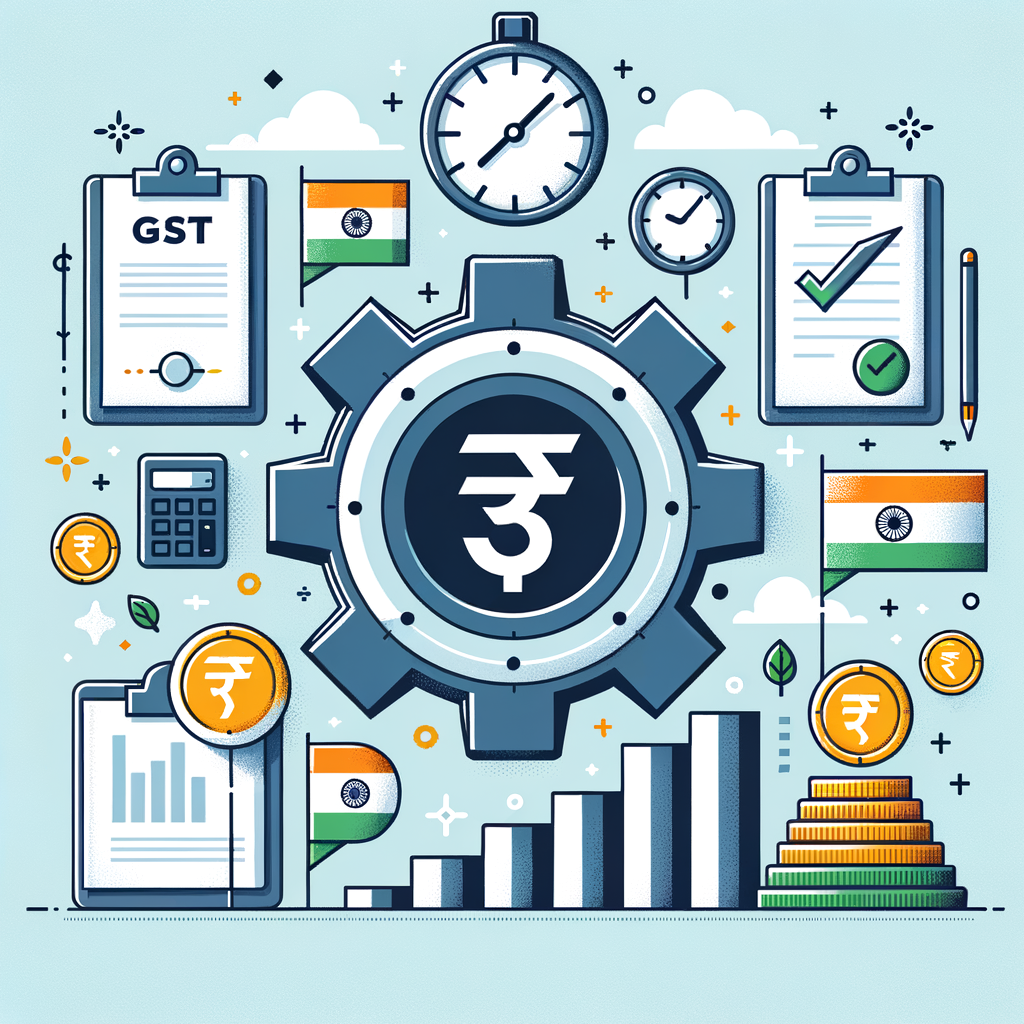The Benefits of Automating GST Compliance Processes for Your Business in India
Are you spending more time on GST paperwork than on growing your business? For countless Indian entrepreneurs and small business owners, this is a daily reality. The Goods and Services Tax (GST) system, while designed to simplify taxation, comes with its own set of complexities and rigorous compliance demands. The constant cycle of invoicing, reconciliation, and filing can feel overwhelming. This is where a strategic shift towards automating compliance processes becomes a game-changer. Manual handling of GST is not just time-consuming; it’s a significant business risk, opening the door to human errors, penalties, and scrutiny from the tax authorities. In this article, we will explore the tangible benefits of compliance automation for businesses and explain why automating compliance processes India-wide is no longer an option, but a necessity for sustainable growth, especially for small and medium enterprises (SMEs). Understanding The Impact of GST on Small and Medium Enterprises is crucial for navigating this landscape.
What is GST Compliance? The Manual Grind for Indian SMEs
Before we dive into the solution, it’s crucial to understand the problem. GST compliance is the set of activities a registered business must perform to adhere to the GST laws. When tackled manually, these tasks can quickly become a bottleneck, draining valuable resources and focus away from your core operations. This manual grind involves a series of interconnected, repetitive, and detail-oriented tasks that leave little room for error.
A Quick Refresher on GST Compliance Tasks
At its core, GST compliance for a typical business involves several critical steps that must be performed accurately and on time. These aren’t just one-off tasks but a continuous cycle that requires constant vigilance. The key activities include:
- Accurate Invoice Generation: Creating GST-compliant invoices with the correct details, including HSN/SAC codes, GSTINs, and tax rates. This has become even more critical with the phased implementation of mandatory e-invoicing for specified businesses.
- Timely Filing of Returns: Submitting various monthly, quarterly, and annual returns to declare your sales, purchases, and tax liabilities. For a detailed walkthrough, you can refer to our guide on How to File GST Returns Online: A Step-by-Step Guide of the GST Filing Process & Procedure. This includes GSTR-1 (for sales/outward supplies), GSTR-3B (a summary return with tax payment), and GSTR-9 (the annual consolidated return).
- Meticulous Input Tax Credit (ITC) Reconciliation: This is one of the most challenging manual tasks. It involves carefully matching the purchase invoices in your books with the data your suppliers have uploaded to the government’s portal (visible in your GSTR-2A and GSTR-2B). Exploring the ITC Reconciliation: Importance and Best Practices for Businesses can highlight why automation is so critical. Any mismatch can lead to lost credits.
- Generation of E-Way Bills: For businesses moving goods valued over a certain threshold, generating an e-way bill from the official portal is mandatory before transportation can begin.
These tasks are all managed through the official GST Portal, which serves as the central hub for all compliance activities.
The Pitfalls of a Manual Approach
Relying on spreadsheets and manual data entry to manage the tasks listed above is a high-risk strategy in the digital age. This approach is fraught with inefficiencies and dangers that can directly harm your business’s financial health and reputation.
| Challenge | Impact of Manual Process | Advantage of Automated Process |
|---|---|---|
|
Human Error |
A single typo in an invoice number or GSTIN can cause a mismatch, leading to incorrect filings, rejected ITC claims, and potential notices from the tax department. The risk multiplies with transaction volume. |
Systems validate data in real-time against GSTN records, flagging errors instantly. This ensures a near-zero error rate in filings and data entry. |
|
Time Drain |
Your finance team or accountant spends dozens of hours each month manually entering data, cross-checking spreadsheets, and reconciling hundreds of invoices. This is valuable time that could be spent on strategic financial planning. |
Repetitive tasks are completed in minutes. Automation pulls data, reconciles ITC, and prepares returns automatically, freeing up your team for high-value work. |
|
Delayed ITC Claims |
Manually reconciling purchase data with GSTR-2B is slow and cumbersome. This often leads to delays in identifying and claiming eligible Input Tax Credit, directly tying up your working capital and affecting cash flow. |
Software performs three-way matching (purchase register vs. GSTR-2A/2B) in seconds, ensuring you claim every eligible rupee of ITC promptly, which improves your cash flow. |
|
Compliance Risk |
GST laws, rules, and deadlines are constantly evolving. Manually keeping track of these changes is difficult and increases the risk of accidental non-compliance, leading to interest and late filing penalties. |
Reputable compliance software is always updated with the latest GST laws and due dates. The system sends automated alerts, ensuring you are always compliant and never miss a deadline. |
The Core Benefits of Automating GST Compliance Processes
Transitioning from a manual system to an automated one is more than just a process improvement; it’s a strategic investment that yields significant returns. By leveraging technology, businesses can transform their compliance function from a costly burden into a streamlined, efficient, and value-adding operation. The advantages of automating tax processes India offers are clear and impactful, especially for SMEs aiming for growth.
1. Unmatched Accuracy and Error Reduction
The single greatest benefit of automation is the drastic reduction in human error. Automated GST software is designed with built-in validation checks. When data is entered or imported, the system can automatically verify GSTIN formats, check for duplicate invoice numbers, and ensure tax calculations are correct based on predefined rules. This real-time error detection means mistakes are caught at the source, long before they can lead to an incorrect return filing. This proactive approach significantly reduces the chances of receiving scrutiny notices or demand letters from the tax department. Ultimately, this leads to one of the most crucial GST compliance benefits for Indian companies: building a clean, trustworthy compliance record, which is invaluable during assessments or when seeking financing.
2. Significant Savings in Time and Operational Costs
Think about the man-hours your team currently invests in GST compliance. This includes manually keying in sales data, downloading GSTR-2B, matching each purchase invoice line by line, and preparing summary reports for GSTR-3B filing. Automation software can perform these tasks in a fraction of the time. What takes a person days of tedious work can be accomplished by the software in minutes. This translates directly into operational cost savings. You can reduce the need for extensive manual labor dedicated to compliance, avoid paying hefty late filing fees and penalties, and reallocate your skilled finance professionals to more strategic activities like financial analysis, budgeting, and business planning.
3. Improved Cash Flow with Faster ITC Reconciliation
For any business, cash flow is king. Input Tax Credit (ITC) is a vital component of the GST system that allows you to reduce your tax liability, directly impacting your working capital. However, you can only claim ITC if your purchase records perfectly match your suppliers’ filed returns (GSTR-1), which are reflected in your GSTR-2A/2B. Manually reconciling this can be a nightmare, often resulting in businesses either delaying their claims or missing out on eligible credit altogether. Automated tools change this entirely. They seamlessly connect with the GSTN, fetch your GSTR-2B data, and run an automated reconciliation against your purchase register. The software instantly highlights matched, mismatched, and missing invoices, allowing you to follow up with vendors promptly and claim 100% of your eligible ITC every month, boosting your available cash.
4. Enhanced Control and Real-Time Visibility
Manual compliance often means your financial data is scattered across multiple spreadsheets, making it difficult to get a clear, up-to-the-minute picture of your GST position. Automation centralizes all your compliance data into a single, intuitive dashboard. With a few clicks, you can see your total tax liability for the month, the amount of ITC available for claim, the status of your filed returns, and any pending compliance actions. This real-time visibility empowers business owners and finance heads to make proactive, data-driven decisions. You can forecast tax outflows more accurately, manage your cash flow better, and have all the necessary reports ready at your fingertips for internal reviews or audits.
5. Scalability for Growing Businesses
A manual GST process might seem manageable when you have 50 transactions a month. But what happens when your business grows and you’re dealing with 500 or 5,000 transactions? Manual systems simply cannot scale. The workload increases exponentially, errors become more frequent, and compliance starts to become a major bottleneck that hinders your growth. This is where compliance automation for SMEs in India is most critical. An automated solution is built to handle volume. It can process thousands of transactions as easily as it processes ten. As your business grows, your compliance system scales effortlessly with you, ensuring that you remain 100% compliant without your processes breaking down. This allows you to focus on expanding your business, confident that your tax compliance foundation is solid and secure.
How to Start Automating Tax Compliance Processes in India
Embarking on the journey of automation may seem daunting, but it can be a smooth and straightforward process with the right approach and partner. The key is to choose the right tools and seek expert guidance to ensure a successful implementation that aligns with your business needs.
Choosing the Right Automation Tools
Not all GST software is created equal. When evaluating options, look for a solution that is robust, user-friendly, and equipped with the features that will truly simplify your life. Here are the must-have features to look for:
- Cloud-Based Accessibility: Your data should be accessible from anywhere, anytime, ensuring you and your team can manage compliance remotely.
- Direct Integration with Accounting Software: The tool should seamlessly integrate with popular accounting software like Tally, Zoho Books, or QuickBooks to eliminate manual data export and import.
- Automated ITC Reconciliation: This is a non-negotiable feature. The software must offer advanced reconciliation that matches data against GSTR-2B and provides clear reports on discrepancies.
- E-invoicing and E-way Bill Generation: If your business falls under these mandates (or will in the future), having a tool that can generate e-invoices and e-way bills directly is a massive advantage.
- Secure Data Handling and User-Friendly Interface: The platform must use top-tier security protocols to protect your sensitive financial data, and its interface should be intuitive enough for your team to use without extensive training.
Partnering with an Expert: The TaxRobo Advantage
Technology is a powerful enabler, but it’s only half of the solution. GST law is complex and nuanced, and having an expert to guide you is crucial for ensuring complete compliance. This is where TaxRobo comes in. We believe in a hybrid approach that combines best-in-class automation software with the oversight of seasoned tax professionals. We help you navigate the complexities of automating tax compliance processes in India, ensuring a smooth transition and long-term success. Our team helps you select and implement the right software for your specific needs and provides continuous expert support to handle any complexities that arise, ensuring you are always 100% compliant.
Let TaxRobo guide your transition to effortless GST compliance. Schedule a free consultation with our experts today!
Conclusion
In a rapidly digitalizing Indian economy, clinging to manual methods for a critical function like GST compliance is no longer a viable strategy. It’s a direct path to inefficiency, financial loss, and unnecessary risk. The move towards automating compliance processes is a fundamental shift from reactive problem-solving to proactive, strategic management. The benefits are undeniable: superior accuracy, significant savings in time and money, optimized cash flow through timely ITC, and the scalability to support your business’s growth ambitions. Embracing automation is not a luxury; it’s a competitive necessity that empowers you to focus on what you do best—running and growing your business.
Stop letting manual GST tasks hold your business back. Contact TaxRobo to discover the perfect automation strategy for you.
Frequently Asked Questions (FAQ)
1. Is automating GST compliance too expensive for a small business?
While there’s an initial investment in software and setup, the long-term Return on Investment (ROI) is substantial. When you factor in the man-hours saved, the costly penalties avoided, the interest on delayed tax payments, and the direct cash flow benefit from timely ITC claims, the cost is easily justified. Many modern, cloud-based solutions are offered on a subscription basis and are priced specifically for the budget of SMEs, making them highly affordable.
2. Can I start by automating just one part of my GST process?
Absolutely. A phased approach is a great way to start. Many businesses begin their automation journey by tackling their biggest pain point first, which is often ITC reconciliation or e-invoicing. Once they experience the benefits and become comfortable with the new system, they can progressively automate other areas like return preparation and filing. This allows for a gradual and manageable transition.
3. How is dedicated GST software different from my regular accounting software?
This is a common and important question. Your accounting software (like Tally or Zoho Books) is primarily for bookkeeping—recording your day-to-day financial transactions. While it stores the necessary data, it is not built for the specialized tasks of GST compliance. Dedicated GST software is designed specifically to interact with the GST Network (GSTN) portal. It has advanced features for real-time ITC reconciliation against GSTR-2B, complex data validation to prevent errors, and seamless one-click return filing capabilities, all of which go far beyond the scope of standard accounting packages.
4. How secure is my financial data with these automation tools?
Data security is a top priority for reputable compliance software providers. These platforms use industry-standard security measures, including end-to-end data encryption, secure login protocols, and hosting on highly reliable and protected cloud servers like Amazon Web Services (AWS) or Microsoft Azure. When choosing a partner, always opt for a trusted provider like TaxRobo, which places the utmost importance on the confidentiality and security of your financial data.



